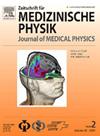Source-detector trajectory optimization for CBCT metal artifact reduction based on PICCS reconstruction
IF 4.2
4区 医学
Q2 RADIOLOGY, NUCLEAR MEDICINE & MEDICAL IMAGING
引用次数: 0
Abstract
Precise instrument placement plays a critical role in all interventional procedures, especially percutaneous procedures such as needle biopsies, to achieve successful tumor targeting and increased diagnostic accuracy. C-arm cone beam computed tomography (CBCT) has the potential to precisely visualize the anatomy in direct vicinity of the needle and evaluate the adequacy of needle placement during the intervention, allowing for instantaneous adjustment in case of misplacement. However, even with the most advanced C-arm CBCT devices, it can be difficult to identify the exact needle position on CBCT images due to the strong metal artifacts around the needle. In this study, we proposed a framework for customized trajectory design in CBCT imaging based on Prior Image Constrained Compressed Sensing (PICCS) reconstruction with the goal of reducing metal artifacts in needle-based procedures. We proposed to optimize out-of-plane rotations in three-dimensional (3D) space and minimize projection views while reducing metal artifacts at specific volume of interests (VOIs). An anthropomorphic thorax phantom with a needle inserted inside and two tumor models as the imaging targets were used to validate the proposed approach. The performance of the proposed approach was also evaluated for CBCT imaging under kinematic constraints by simulating some collision areas on the geometry of the C-arm. We compared the result of optimized 3D trajectories using the PICCS algorithm and 20 projections with the result of a circular trajectory with sparse view using PICCS and Feldkamp, Davis, and Kress (FDK), both using 20 projections, and the circular FDK method with 313 projections. For imaging targets 1 and 2, the highest values of structural similarity index measure (SSIM) and universal quality index (UQI) between the reconstructed image from the optimized trajectories and the initial CBCT image at the VOI was calculated 0.7521, 0.7308 and 0.7308, 0.7248 respectively. These results significantly outperformed the FDK method (with 20 and 313 projections) and the PICCS method (20 projections) both using the circular trajectory. Our results showed that the proposed optimized trajectories not only significantly reduce metal artifacts but also suggest a dose reduction for needle-based CBCT interventions, considering the small number of projections used. Furthermore, our results showed that the optimized trajectories are compatible with spatially constrained situations and enable CBCT imaging under kinematic constraints when the standard circular trajectory is not feasible.
基于 PICCS 重建的 CBCT 金属伪影减少源-探测器轨迹优化。
精确的器械放置在所有介入手术中都起着至关重要的作用,尤其是经皮手术,如针穿活检,这样才能成功瞄准肿瘤并提高诊断准确性。C 型臂锥形束计算机断层扫描(CBCT)可以精确地观察到穿刺针直接附近的解剖结构,并在介入过程中评估穿刺针放置的适当性,以便在放置错误时立即进行调整。然而,即使是最先进的 C 型臂 CBCT 设备,也很难在 CBCT 图像上确定针的准确位置,因为针周围有很强的金属伪影。在这项研究中,我们提出了一个基于先验图像约束压缩传感(PICCS)重建的 CBCT 成像定制轨迹设计框架,目的是减少针式手术中的金属伪影。我们建议优化三维(3D)空间中的平面外旋转,尽量减少投影视图,同时减少特定感兴趣容积(VOI)上的金属伪影。为了验证所提出的方法,我们使用了一个拟人胸腔模型,模型内部插入了一根针,并使用两个肿瘤模型作为成像目标。我们还通过模拟 C 臂几何形状上的一些碰撞区域,评估了所提方法在运动学约束条件下的 CBCT 成像性能。我们比较了使用 PICCS 算法和 20 个投影的优化三维轨迹结果,以及使用 PICCS 和 Feldkamp、Davis 和 Kress(FDK)(均使用 20 个投影)的稀疏视图圆形轨迹结果,以及使用 313 个投影的圆形 FDK 方法。对于目标 1 和目标 2 的成像,优化轨迹重建图像与 VOI 处初始 CBCT 图像之间的结构相似性指数(SSIM)和通用质量指数(UQI)的最高值分别为 0.7521、0.7308 和 0.7308、0.7248。这些结果明显优于使用圆形轨迹的 FDK 方法(20 个和 313 个投影)和 PICCS 方法(20 个投影)。我们的结果表明,考虑到所使用的投影数量较少,建议的优化轨迹不仅能显著减少金属伪影,还能减少针式 CBCT 介入的剂量。此外,我们的结果表明,优化轨迹与空间受限情况兼容,当标准圆形轨迹不可行时,可在运动学受限的情况下进行 CBCT 成像。
本文章由计算机程序翻译,如有差异,请以英文原文为准。
求助全文
约1分钟内获得全文
求助全文
来源期刊
CiteScore
3.70
自引率
10.00%
发文量
69
审稿时长
65 days
期刊介绍:
Zeitschrift fur Medizinische Physik (Journal of Medical Physics) is an official organ of the German and Austrian Society of Medical Physic and the Swiss Society of Radiobiology and Medical Physics.The Journal is a platform for basic research and practical applications of physical procedures in medical diagnostics and therapy. The articles are reviewed following international standards of peer reviewing.
Focuses of the articles are:
-Biophysical methods in radiation therapy and nuclear medicine
-Dosimetry and radiation protection
-Radiological diagnostics and quality assurance
-Modern imaging techniques, such as computed tomography, magnetic resonance imaging, positron emission tomography
-Ultrasonography diagnostics, application of laser and UV rays
-Electronic processing of biosignals
-Artificial intelligence and machine learning in medical physics
In the Journal, the latest scientific insights find their expression in the form of original articles, reviews, technical communications, and information for the clinical practice.

 求助内容:
求助内容: 应助结果提醒方式:
应助结果提醒方式:


